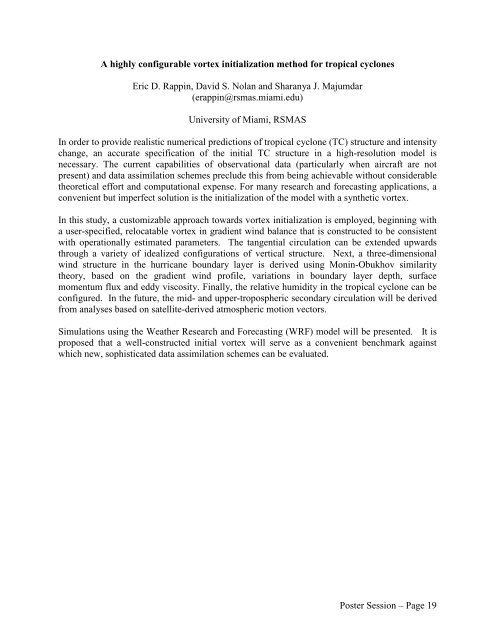65th IHC Booklet/Program (pdf - 4.9MB) - Office of the Federal ...
65th IHC Booklet/Program (pdf - 4.9MB) - Office of the Federal ...
65th IHC Booklet/Program (pdf - 4.9MB) - Office of the Federal ...
You also want an ePaper? Increase the reach of your titles
YUMPU automatically turns print PDFs into web optimized ePapers that Google loves.
A highly configurable vortex initialization method for tropical cyclones<br />
Eric D. Rappin, David S. Nolan and Sharanya J. Majumdar<br />
(erappin@rsmas.miami.edu)<br />
University <strong>of</strong> Miami, RSMAS<br />
In order to provide realistic numerical predictions <strong>of</strong> tropical cyclone (TC) structure and intensity<br />
change, an accurate specification <strong>of</strong> <strong>the</strong> initial TC structure in a high-resolution model is<br />
necessary. The current capabilities <strong>of</strong> observational data (particularly when aircraft are not<br />
present) and data assimilation schemes preclude this from being achievable without considerable<br />
<strong>the</strong>oretical effort and computational expense. For many research and forecasting applications, a<br />
convenient but imperfect solution is <strong>the</strong> initialization <strong>of</strong> <strong>the</strong> model with a syn<strong>the</strong>tic vortex.<br />
In this study, a customizable approach towards vortex initialization is employed, beginning with<br />
a user-specified, relocatable vortex in gradient wind balance that is constructed to be consistent<br />
with operationally estimated parameters. The tangential circulation can be extended upwards<br />
through a variety <strong>of</strong> idealized configurations <strong>of</strong> vertical structure. Next, a three-dimensional<br />
wind structure in <strong>the</strong> hurricane boundary layer is derived using Monin-Obukhov similarity<br />
<strong>the</strong>ory, based on <strong>the</strong> gradient wind pr<strong>of</strong>ile, variations in boundary layer depth, surface<br />
momentum flux and eddy viscosity. Finally, <strong>the</strong> relative humidity in <strong>the</strong> tropical cyclone can be<br />
configured. In <strong>the</strong> future, <strong>the</strong> mid- and upper-tropospheric secondary circulation will be derived<br />
from analyses based on satellite-derived atmospheric motion vectors.<br />
Simulations using <strong>the</strong> Wea<strong>the</strong>r Research and Forecasting (WRF) model will be presented. It is<br />
proposed that a well-constructed initial vortex will serve as a convenient benchmark against<br />
which new, sophisticated data assimilation schemes can be evaluated.<br />
Poster Session – Page 19
















